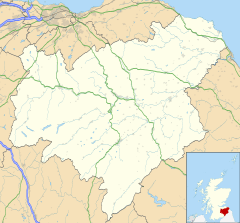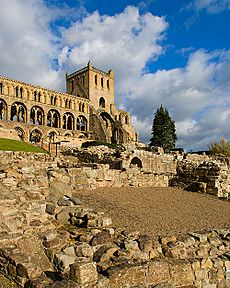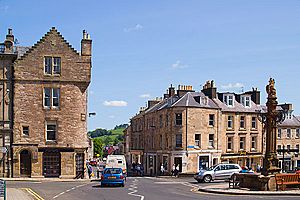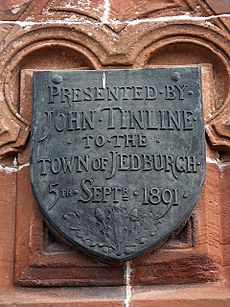Jedburgh facts for kids
Quick facts for kids Jedburgh
|
|
|---|---|
 "Strenue et Prospere", Earnestly and Successfully |
|
| Area | 1.74 km2 (0.67 sq mi) |
| Population | 3,860 (2020) |
| • Density | 2,218/km2 (5,740/sq mi) |
| OS grid reference | NT649205 |
| • Edinburgh | 41 mi (66 km) NW |
| Civil parish |
|
| Council area | |
| Lieutenancy area |
|
| Country | Scotland |
| Sovereign state | United Kingdom |
| Post town | JEDBURGH |
| Postcode district | TD8 |
| Dialling code | 01835 |
| Police | Lothian and Borders |
| Fire | Lothian and Borders |
| Ambulance | Scottish |
| EU Parliament | Scotland |
| UK Parliament |
|
| Scottish Parliament | |
| Website | www.jedburgh.org.uk |
Jedburgh (pronounced JED-bər-ə) is a town in the Scottish Borders. It used to be a "royal burgh", which means it had special rights from the king or queen. It is also the main town of the historic area called Roxburghshire.
Contents
Exploring Jedburgh's Past
Early Beginnings and the Abbey
A church was first built in Jedburgh in the 800s by a bishop named Ecgred of Lindisfarne. Later, King David I turned it into a priory, a type of monastery, for Augustinian monks from France. In 1147, it became a big abbey. But sadly, wars with England in the 1500s left the abbey in ruins.
A Scottish king named Malcolm IV died here in 1165 when he was only 24.
Jedburgh Castle: A Royal Stronghold
King David I also built a castle in Jedburgh. In 1174, this castle was one of five strongholds given to England. Scottish kings sometimes lived there. However, the English captured it so often that it was finally torn down in 1409. By then, it was the last English castle left in Scotland.
In 1258, Jedburgh was important for talks between King Alexander III of Scotland and King Henry III of England. They discussed who would be the next Scottish king. In 1285, King Alexander III was married in the abbey.
Trade and Raids
Because Jedburgh was so close to England, it often faced attacks and small battles. But its location also helped the town with valuable trade. Over time, Jedburgh had markets for horses, cattle, corn, and meat. Farm workers also came to hiring fairs to find jobs.
Mary, Queen of Scots, stayed in a house in Jedburgh in 1566. That house is now a museum you can visit.
Important Titles and Events
The title "Lord of Jedburgh Forest" was given to George Douglas, 1st Earl of Angus in 1397. This was when he married Princess Mary, the daughter of King Robert III. Today, this is a smaller title held by the Duke of Hamilton.
In 1745, the Jacobite army, led by Prince Charles Edward Stuart, marched through Jedburgh on their way to England. The Prince also stayed in the town. The Castle Prison opened in 1823.
In 1787, a scientist named James Hutton studied rocks near Jedburgh. He noticed something special: layers of rock that were tilted almost straight up were covered by new, flat layers. This helped him understand that Earth's history is incredibly long, with "no sign of a beginning, no hope of an end."
The saying "Jeddart justice" or "Jethart Justice" means someone was punished first and then tried. This idea came from a time when a group of criminals was quickly dealt with.
Jedburgh's Location and Landmarks
Jedburgh is located on the Jed Water, which is a small river that flows into the River Teviot. It is about 10 miles (16 km) from the border with England. The town is famous for the large ruins of Jedburgh Abbey.
Other important buildings in Jedburgh include Queen Mary's House, which is now a museum, and the Jedburgh Castle Jail, also a museum. The Jedburgh Library is another notable building.
Nearby places include Ancrum, Bonjedward, Camptown, Crailing, and Oxnam.
Famous People from Jedburgh
Many famous people were born in Jedburgh or have strong connections to the town:
- Mary Somerville, born in 1780, was a brilliant scientist and writer. A college at Oxford University is named after her, and her picture was on a Scottish £10 note.
- James Thomson (1700–1748), who wrote the song "Rule Britannia", was educated in Jedburgh.
- David Brewster, born in 1781, was a physicist, mathematician, and the inventor of the kaleidoscope.
- General Sir Bindon Blood was born nearby in 1842.
- Alexander Jeffrey, a local lawyer, was also the county historian.
- The author Lavinia Derwent was born near Jedburgh in 1909.
- The Tinline brothers, George Tinline and John Tinline, moved from Jedburgh in the 1830s. George became successful in banking in Australia, and John made his money farming in New Zealand. John later returned to Jedburgh and gave Allerley Well Park to the town.
Jedburgh is also known for its rugby players, including Roy Laidlaw, his nephew Greig Laidlaw (who captained the Scotland team), and Gary Armstrong. Boxer Douglas Young competed in the 1984 Summer Olympics.
Emmy Award-winning journalist Nick Watt is from Jedburgh. He even hosted a short film about the town for the Travel Channel.
Jedburgh Today
The Jedburgh Abbey ruins are looked after by Historic Environment Scotland and are open to visitors (there is an entry fee). You can see items found during digs at the visitor centre. Even though the abbey is very old and damaged, much of its original structure is still standing.
Jedburgh has many traditions and events. These include the yearly Callant's Festival, the Jedburgh Pipe Band, and the Jedforest Instrumental Band. Local treats include Jethart Snails, which are boiled sweets shaped like snails. They are said to come from a recipe given by a French prisoner during the Napoleonic Wars. Another local specialty is Jethart pears. The rich soil around Jedburgh is great for growing pear trees, and selling pears was a big business here for centuries.
An exciting yearly event is the Jethart Hand Ba game, a traditional ball game.
The Canongate Brig is a bridge that dates back to the 1500s. The nearby Capon Oak Tree is a very important old tree. The 19th-century Jedburgh Castle Jail and Newgate, with its spire, are also important buildings in the town.
Schooling in Jedburgh now takes place at the Jedburgh Intergenerational Community Campus, which opened in early 2020.
Getting Around Jedburgh
Jedburgh no longer has train access, but it is easy to reach by road. The A68 road connects it directly to Edinburgh (about 48 miles or 77 km away) and Newcastle-upon-Tyne (about 58 miles or 93 km away). Carlisle is 57 miles (92 km) away. Other nearby towns like Hawick, Kelso, and Galashiels are all within 20 miles (32 km).
Drivers from Edinburgh and Newcastle-upon-Tyne will see signs for Jedburgh as a main destination on the A68 road.
Bus services in Jedburgh are provided by Borders Buses.
Sports in Jedburgh
The town is home to a rugby club called Jed-Forest, which started in 1885. Younger players (under 18) play for Jed Thistle.
Football is played by Jed Legion FC. They are part of the Border Amateur League. Ancrum AFC plays in the nearby village of Ancrum.
Jedburgh also has a golf club that opened in 1892, with an 18-hole course.
See also
 In Spanish: Jedburgh para niños
In Spanish: Jedburgh para niños








